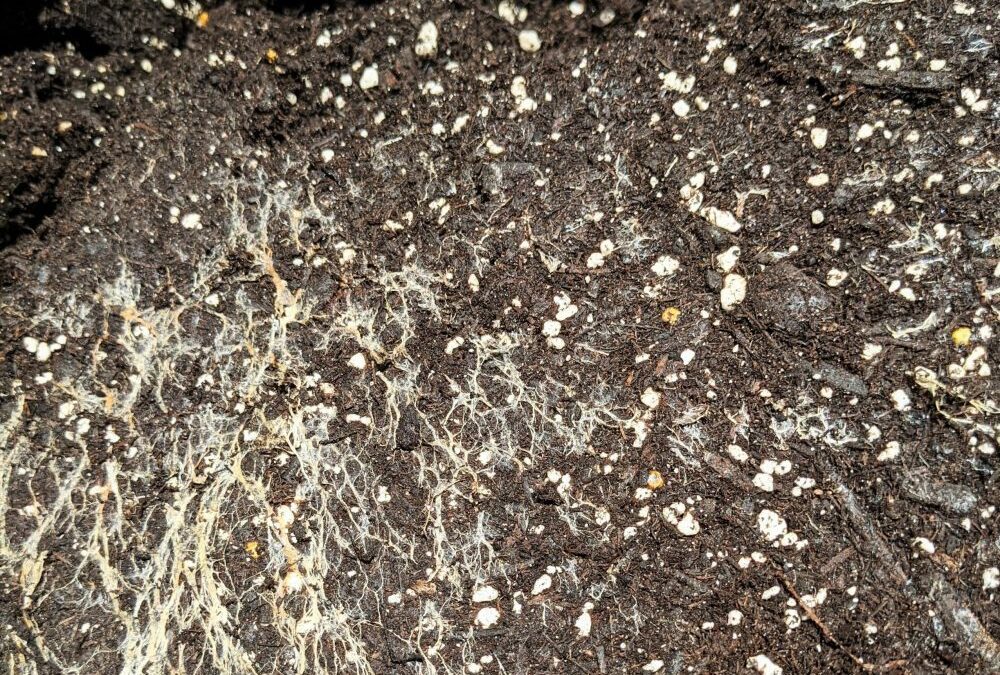Living soil is all about diversity. Diversity of fungi, bacteria, protozoa, nematodes, arthropods, and earthworms breaking down organic matter that produces nutrients for plants to use. Who knew it was all of those things that makes a soil healthy…a living soil!
First, let’s talk about healthy fungus and bacteria.
Mycorrhizae is “a fungus that grows in association with the roots of a plant in a symbiotic or mildly pathogenic relationship”. Imagine a network of fungi that connects plants to one another and their relationship to eachother as mutually beneficial.
“a fungus that grows in association with the roots of a plant in a symbiotic or mildly pathogenic relationship”. Imagine a network of fungi that connects plants to one another and their relationship to eachother as mutually beneficial.
Plants feed the Mycorrhizae and Mycorrhizae help feed the plants. Untamed Science has an article that goes into more depth on Mycorrhizae. Have you heard of how plants have their own internet and can talk to each other? Read about it here from the BBC.
The three different kinds of Bacillus contained in this label on the right all have their own roles in the nutrient uptake of a plant. For example Bacillus megaterium is a phosphate solubilizing bacteria (PSB). As the name suggests it helps the nutrient phosphate become available for the plant. Others are nitrogen solubilizing bacteria and some are potassium solubilizing bacteria. Bacillus and Mycorrhizae will improve the growth of the plant, it’s nutrient uptake capabilities, and boost its immunity to disease.
Hopefully you will read more about these amazing underground webs of fungi and bacteria to better understand what they are doing but sometimes we just need to know…
“How can I ensure my soil is a ‘living soil’?”
1. Test your soil pH and nutrients. We carry SOILKIT, soil testing kit that you send in, with a postage paid envelope included, for them to analyze or you can submit a soil sample to the U of M.
2. When you plant a new plant into the ground use a fertilizer that contains these Bacillus and Myccorrhizae (Ectomycorrhizal Fungi – as seen on the label above). This will help build those highways of networking fungi and bacteria to boost your plants nutrient uptake. See the second image down of the tomatoes grown with and  without Biotone. Incredible difference!
without Biotone. Incredible difference!
3. Try practicing a low till method of gardening. No-till farming has become a conservation effort for soil and water and low till or no-till gardening experience has shown that tilling the ground can interrupt these networks of fungi beneficial to our plants. If you add organic compost or manure on-top of your soil instead of tilling it in, it will slowly add the nutrients your soil needs. Less hard-work digging up dirt and better for the soil! Win win! You may need to use tilling to break up compacted sod when converting soil for a garden but even then if you lay a thick layer of compost over the sod or try the “black-out” method of covering the sod with newspaper, cardboard, or whatever blocks the sun out until it dies, then putting dirt on top, has worked just fine! Just keep in mind this takes a few years to create the healthiest soil, depending on how deficient or compacted it was before.
4. No bare soil! Keep your soil covered with mulch or a living ground cover. If you have  dried grass clippings, use that! If you have leaves, use that! It is important to note that any diseased foliage should not be used as mulch.
dried grass clippings, use that! If you have leaves, use that! It is important to note that any diseased foliage should not be used as mulch.
Any mulch will help reduce evaporation of water (less watering, yah!), stop weeds from growing, and add nutrients to your soil over time as it breaks down. Another method to cover your soil is planting a cover crop or ground cover to stop weeds and to feed the soil! Some examples are oat, field pea, hairy vetch and buckwheat. See the buckwheat cover crop on the image to the right. This piece of soil was very nutrient deficient and needed a nitrogen fixating plant. The plant actually puts nitrogen into the soil! The blooms were great for pollinators also!
5. An added bonus of using a cover crop is it makes your own green manure. When you grow a cover crop you can leave the uprooted or sown crop to die once winter hits and leave it there until spring and lightly work into the soil or use as a natural mulch.
6. Soil aeration is very important. Keep permanent paths to walk on in-between your crop rows. This prevents the soil around your plants from compacting and interrupting the proper water and oxygen balance. Just like us, we need water and oxygen and when soil gets compacted it doesn’t hold the correct percentage (25% of each) of water and oxygen for healthy plants. The compost you added to your soil is also going to help aeration because it adds non-compacted organic matter and brings in earthworms who help aerate soil. If you don’t see earthworms, you know you don’t have enough delicious organic matter for them to eat. Add composted plant material and manure to help bring in the worms!
Soil health is one of the important part of our gardening efforts and understanding what it needs will help grow vigorous, healthy, and productive plants.
Read more about cover crops and green manure from the UMN Extension and check out their cover crop article and selector tool.
All About Soil Gardeners.com

